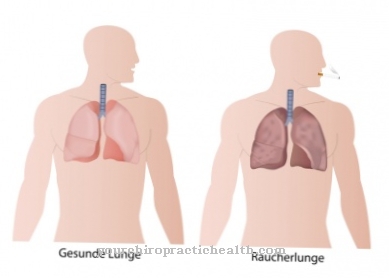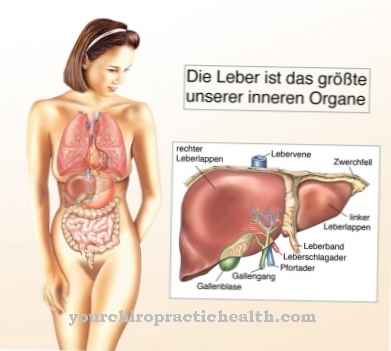Varenicline helps smokers with withdrawal
Quitting smoking poses an immense challenge for those affected. The chances of success of withdrawal can be increased by nicotine substitutes such as plasters or chewing gum.
If these attempts fail, a possible alternative is therapy with varenicline. The drug has been tried and tested and the positive effect on the process of weaning has been documented in studies. However, the drug has severe side effects and does not help all smokers.
Effects of varenicline

Within a few seconds after ingesting nicotine, the feeling-enhancing effect unfolds in the consumer's brain. The addictive substance binds to alpha-4-beta-2 receptors in the nerve cells and triggers the formation of acetylcholine (source: Spektrum.de).
The messenger substance immediately excites an area of the brain that is responsible for the reward. As the stimulating effect subsides, the desire arises to restore the experienced state by smoking again. Varenicline intervenes in this mechanism by targeting the nicotine receptors.
The binding of the active ingredient still leads to the production of acetylcholine, but to a much lesser extent. In contrast to treatment-free weaning, a minimal reward is retained, which means that withdrawal symptoms are reduced.
At the same time, varenicline displaces existing nicotine from the receptors and prevents the addictive substance from being tied up again. As a result, the consumption of tobacco remains free of effects and the desire to smoke decreases.
Varenicline as a drug
In Europe, varenicline has been available as a drug under the brand name Champix (Pfizer) since 2006. The drug can be prescribed by the doctor to adults in the case of severe nicotine dependence and is taken as a film-coated tablet. Studies for children and adolescents under the age of 18 are not available.
The active ingredient is not prescribed during pregnancy because animal experiments have shown that it is harmful to offspring. Varenicline also passes into breast milk. Either breastfeeding or therapy must therefore be stopped during breastfeeding.Researchers from the Pharmacogenomics Research Network also recommend determining the patient's metabolism prior to treatment.
A simple blood test will determine how quickly the nicotine is broken down by the liver. According to the study, varenicline is suitable for people with high metabolism (Lancet Respiratory Medicine, vol. 3, no. 2, 131-138, 2015).
In contrast, there was no benefit in patients who only break down the addictive substance slowly. In addition, they complained more often about side effects, so that in these cases the conventional and cheaper treatment with nicotine substitutes is preferable.
A simple blood test will determine how quickly the nicotine is broken down by the liver. According to the study, varenicline is suitable for people with high metabolism (Lancet Respiratory Medicine, vol. 3, no. 2, 131-138, 2015).
In contrast, there was no benefit in patients who only break down the addictive substance slowly. In addition, they complained more often about side effects, so that in these cases the conventional and cheaper treatment with nicotine substitutes is preferable.
application
Therapy with varenicline should begin before smoking is stopped, but can also take place with a parallel reduction in tobacco consumption. During the first seven days, the daily dose is gradually increased to two milligrams and the application is carried out over a period of at least twelve weeks.
The success of the therapy depends to a large extent on the patient's motivation and can be promoted through targeted behavioral advice. Here, for example, individual strategies are to be discussed with which the patient can cope with stressful situations and suppress his desire to smoke.
Side effects & interactions
The use of varenicline can have significant side effects. The doctor must therefore assess the patient's personal situation precisely before prescribing, weigh the risks and benefits of a therapy and, if necessary, adjust the prescribed dose during treatment.
Disorders of the digestive system are very common, manifesting themselves in nausea, stomach upset, diarrhea and vomiting. Many patients report insomnia and abnormal dreams. In addition, drowsiness and dizziness rarely occur, which leads to limitations in general performance and concentration. Caution is required here, especially when driving a car or operating machines.
The list of other, occasionally occurring side effects is long and affects, among other things, the appetite and libido of the patient, his emotional feeling and the cardiovascular system. The use of varenicline has also been associated with an increase in heart attacks, relapses of depression and suicide in the past.
Subsequent studies ruled out a direct connection between the documented cases and the drug as the cause, but patients with a corresponding previous exposure are encouraged to critically discuss the implementation of the therapy with their doctor in advance. Varenicline continues to interact with other drugs. The following are demonstrably affected:
- Psychotropic drugs (clozapine, olanzapine),
- Pain relievers (paracetamol, caffeine),
- the stomach drug cimetidine,
- the asthma drug theophylline,
- the blood thinner warfarin, insulin
You can find your medication here
➔ Medicines for smoking cessationConclusion
When giving up smoking, the active ingredient varenicline reduces the desire for nicotine and relieves withdrawal symptoms. The smoker's motivation to renounce his vice remains a basic requirement for successful therapy. Due to numerous side effects and interactions, the application must be discussed in detail with the doctor.














.jpg)













